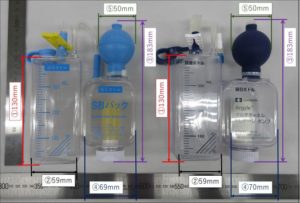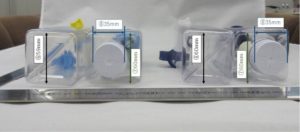October 23,2019
The Intellectual Property High Court decision on August 29, 2019 (Case No. 2019 (Ne) 10002 – the presiding judge Otaka)
(The original decision rendered by the Tokyo District Court on December 26, 2018 [case No. 2018 (W) 13381] – the presiding judge Yamada)
◆ Main text of the case
【Summary of the Judgment】
- Basically, a configuration of goods is selected in light of functions or performances of the goods to be realized or the beauty of the appearance of the goods to be enhanced, and a configuration of goods is not expected to indicate the source of the goods in the first place. However, if a specific configuration of goods of a company has distinctive features which makes the goods distinguishable from other goods of the same kind, and said configuration has been continuously used for the goods for a long time on an exclusive basis, or has been strongly advertised even in a short period of time, this may result in the fact that the configuration has acquired an identification function which indicates the goods belonging to the company, and has become widely known among consumers and/or traders. Such configuration of the goods is considered to fall under “another person’s well-known indication of goods or business” to be protected under Article 2, paragraph (1), item (i) of the Unfair Competition Prevention Act.
- Whether or not a certain indication of goods or business is similar to “another person’s (well-known) indication of goods or business” under Article 2, paragraph (1), item (i) of the Unfair Competition Prevention Act should be determined based on whether or not consumers or traders are likely to accept those two indications as similar overall in terms of impressions, memories and associations by appearances, pronunciations, or concepts of respective indications in the actual situation of transactions.
- In this case, a product configuration of the plaintiff has been continuously used by the plaintiff (the appellant) for approximately 34 years on an exclusive basis, and as a result thereof, the product configuration has acquired a source-identifying function which indicates the source of a product belonging to a specific company, and has become well known among medical workers as consumers as that indicating the source of the product (the product belongs to the plaintiff). Under the circumstances, the defendant (the appellee) started to sell the defendant’s product; a configuration thereof is confusingly similar to that of the plaintiff’s product. In addition, both products are a medical consumable, and their respective sales forms are the same.
In view of the foregoing, it is considered that when medical workers see the defendant’s product configuration which is confusingly similar to the plaintiff’s product configuration through product images appeared in catalogues of medical devices or online shops, they are likely to be misled into believing that both products have the same source. Therefore, the sale of the defendant’s product is found to fall under the act which causes confusion with the plaintiff’s product.
【Comments】
- Regarding the summary of the judgment 1, the Court denied the inherent distinctiveness of the plaintiff’s product configuration, but on the other hand, while acknowledging the possibility of the plaintiff’s product configuration falling under the “(well-known) indication of goods or business” (Article 2, Paragraph 1, Item 1 of the Unfair Competition Prevention Act) by acquisition of the distinctiveness and quality of being well-known through the use thereof, it required to satisfy the following requirements in order for a product configuration to be regarded as an indication of goods or business: (i) a product configuration has distinctive features, (ii) a product configuration has been continuously used for a long time on an exclusive basis, or strongly advertised even in a short period of time. The foregoing is generally accepted in court cases (the Intellectual Property High Court decision on December 26, 2012, Hanrei Jiho No. 2178, p.99 [Glasses-type Loupe case], etc.) and theories (“Annotations to the Unfair Competition Prevention Act published by the Research Group on Industrial Competitiveness and Intellectual Property of METI [the 2d edition]” (2019, Shojihomu), p.63, etc.).
- Regarding the summary of the judgment 2, the Court found that in determining whether or not the plaintiff’s product configuration is similar to the defendant’s product configuration as an indication of goods or business, it is appropriate to rest on the same criterion as the case with the determination on the similarity of the indication of goods or business in general (the Supreme Court decision on October 7, 1983, Minshu Vol. 37, No. 8, p. 1082 [Nihon Woman Power K.K. case], the Supreme Court decision on May 29, 1984, Minshu Vol. 38, No. 7, p. 920 [Football Symbol Mark case], etc.). No divergent opinions are found in court cases and theories.
- Regarding the summary of the judgment 3, the Court was based on the premise that an “act of creating confusion” (set forth in Article 2, Paragraph 1, Item 1 of the Unfair Competition Prevention Act) is interpreted to include not only an act which causes confusion and mislead one into believing that the goods or service comes from the same source or the same business entity (confusion in the narrow sense), but also an act which causes confusion and mislead one into believing that there exist some business relationship between two business entities (confusion in the broad sense) (the Supreme Court decision on September 10, 1998, Hanrei Jiho No. 1655, p. 160 [スナックシャネル(su-na-kku-sha- ne-ru) case], etc.) and in order to call an act as that which causes confusion, it is sufficient if specific likelihood of confusion is present and actual occurrence of confusion is not required, and when making a judgment on the act causing confusion, the Court considered comprehensively the degree to which the plaintiff’s indication of goods or business is well known, the degree of similarity between the indication of goods or business of the plaintiff and that of the defendant, and the degree of proximity of the plaintiff’s goods and the defendant’s goods, in principle. No divergent opinions are found in court cases and theories.
In the original judgment, the lower court, while considering the similarity between the product configuration of the plaintiff and that of the defendant, denied the likelihood of confusion in the broad sense as well as the likelihood of confusion in the narrow sense, placing important on the following points: (i) the strict process rule concerning general transactions of medical devices is adopted in (large-sized) medical organizations, (ii) medical workers as consumers are experts, and recognize a competitive relationship between the plaintiff and the defendant. While on the other hand, in the summary of the judgment 3, the Court acknowledged, based on the comprehensive consideration mentioned above, the likelihood of confusion in the narrow sense, placing emphasis on the following points: (i) the strict process rule mentioned above is not necessarily to be adopted in (small-sized) medical organizations, (ii) the plaintiff’s product and the defendant’s product are relatively inexpensive consumable items which are sold in catalog mail order or through online shops.
- Comparison between the plaintiff’s product and the defendant product (photographs cited from the decision document)
(1) Front face (Left: the plaintiff’s product, Right: the defendant’s product)
(2) Bottom face (Left: the plaintiff’s product, Right: the defendant’s product)
【Keywords】Article 2, Paragraph 1, Item 1 of the Unfair competition Prevention Act, configuration of goods, distinctiveness, well-known, similarity, confusion in the narrow sense, likelihood of confusion, portable disposable low pressure continuous suction device, waste liquid bottle, suction bottle, Sumitomo bakelite, Nippon covidien
※The contents contained herein are for general information only and do not constitute legal advice.
Kei IIDA (the person in charge of this article)
Attorney at Law & Patent Attorney (Daini Tokyo Bar Association)
Contact information for inquiries: k_iida@nakapat.gr.jp

